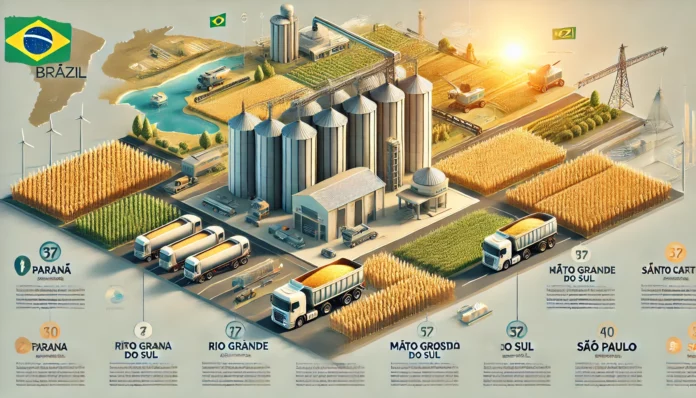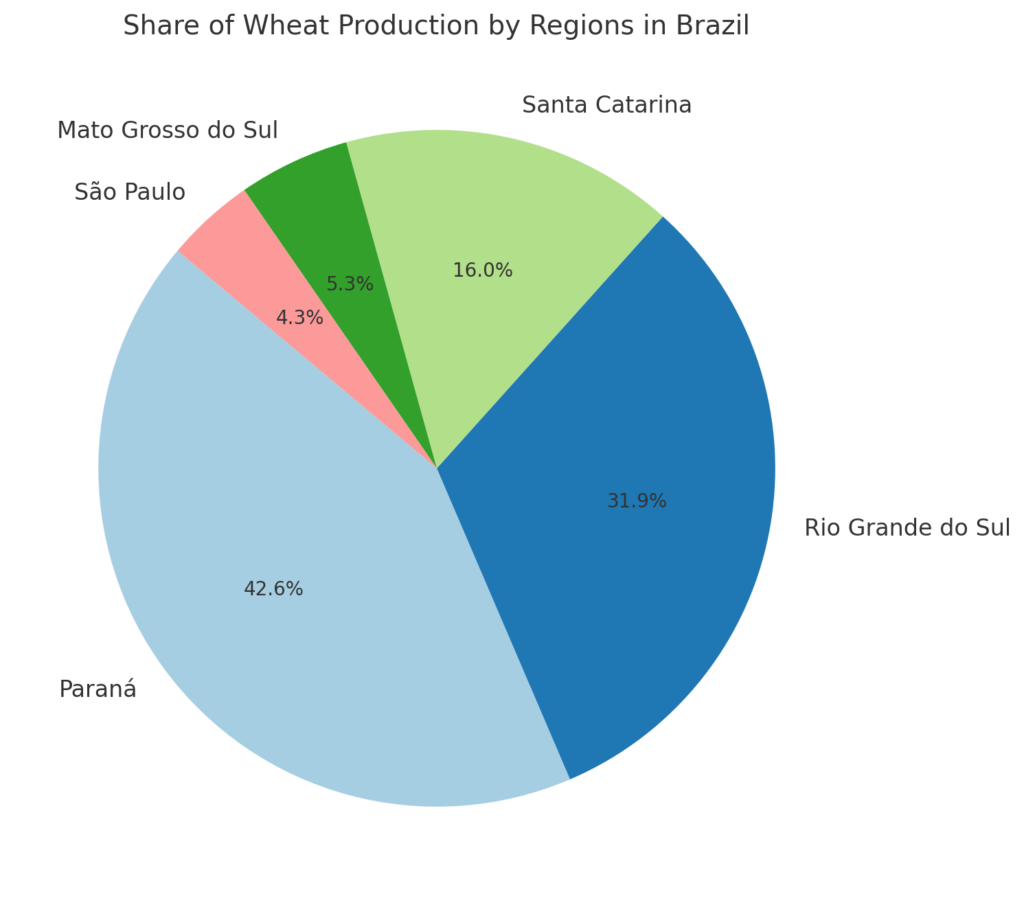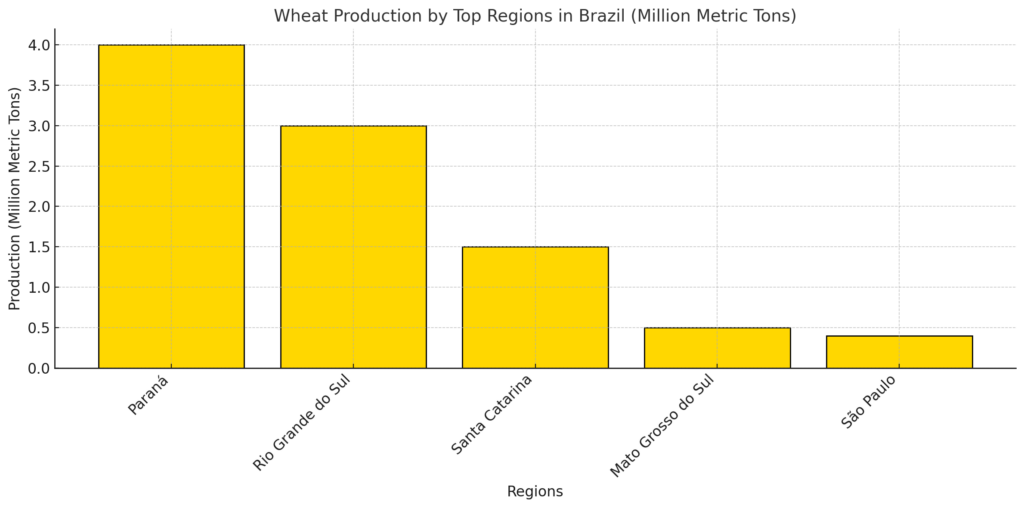
Brazil is one of South America’s largest agricultural producers, and its wheat industry has become increasingly important to global food security. The country has a diverse climate and fertile lands that support the production of various crops, including wheat. This article will explore Brazil’s largest wheat-producing regions, focusing on Paraná, Rio Grande do Sul, and Santa Catarina, and their contributions to both local consumption and international exports.

1. Paraná: Brazil’s Leading Wheat Producer
Paraná is the largest wheat-producing state in Brazil and plays a vital role in the country’s wheat industry.
- Annual Production: Approximately 4 million metric tons.
- Key Areas: Western and central Paraná, with a focus on the Paraná River basin.
- Major Crops: Winter wheat, accounting for the majority of the state’s wheat production.
- Innovations: Paraná has embraced advanced farming technologies, including precision agriculture, and modern irrigation systems to optimize yields.
- Significance: Paraná is the heart of Brazil’s wheat industry, supplying both domestic markets and key international destinations like neighboring countries in South America.
2. Rio Grande do Sul: A Major Wheat Producer in Southern Brazil
Rio Grande do Sul is another important wheat-producing region in Brazil, located in the southernmost part of the country.
- Annual Production: Around 3 million metric tons.
- Key Areas: The southern and central regions of the state, which benefit from the region’s temperate climate.
- Major Crops: Primarily winter wheat, with some spring wheat production in certain areas.
- Innovations: The state utilizes crop rotation techniques to maintain soil fertility and improve wheat yields, alongside modern mechanized farming practices.
- Significance: Rio Grande do Sul contributes significantly to Brazil’s wheat supply, particularly for the domestic market, and is an important exporter to other countries in the region.
3. Santa Catarina: A Growing Wheat Producer in the South
Santa Catarina is another southern state in Brazil that is increasingly recognized for its wheat production.
- Annual Production: Approximately 1.5 million metric tons.
- Key Areas: Central and western regions, including the Upper Itajaí Valley and the region around the capital, Florianópolis.
- Major Crops: Winter wheat is the main crop grown, with a growing focus on high-quality wheat varieties.
- Innovations: Santa Catarina is increasingly adopting sustainable farming practices and innovative milling techniques to produce high-quality wheat.
- Significance: While Santa Catarina’s production is smaller than Paraná and Rio Grande do Sul, it plays an essential role in Brazil’s wheat supply chain and contributes to the region’s food security.
4. Mato Grosso do Sul: A Rising Wheat Producer
While Mato Grosso do Sul is primarily known for its production of soybeans and corn, it is also emerging as a wheat-producing region.
- Annual Production: Around 500,000 metric tons.
- Key Areas: Central Mato Grosso do Sul, with a focus on regions near the Paraná River.
- Major Crops: Wheat, along with other grains and oilseeds.
- Innovations: The state is investing in modern farming equipment and crop management systems to increase wheat production.
- Significance: Mato Grosso do Sul is a growing contributor to Brazil’s wheat industry, supplying wheat for both local consumption and neighboring markets.
5. São Paulo: A Lesser-Known but Growing Wheat Region
São Paulo, Brazil’s most populous state, is a smaller but important wheat producer, especially in its more rural areas.
- Annual Production: Approximately 400,000 metric tons.
- Key Areas: The central and western parts of the state, which have favorable conditions for wheat farming.
- Major Crops: Wheat, corn, and soybeans, often part of an integrated crop rotation system.
- Innovations: São Paulo has been adopting new wheat varieties that are more resistant to pests and diseases, as well as promoting sustainable agricultural practices.
- Significance: While not one of Brazil’s top wheat-producing states, São Paulo’s contribution to wheat production is growing and supports local and regional demand.

Innovations Driving Wheat Production in Brazil
Brazil’s wheat industry has been evolving with the introduction of various innovations aimed at increasing efficiency and sustainability:
- Precision Agriculture: The use of GPS and satellite imagery to monitor crop health, optimize water use, and reduce input costs.
- Sustainable Farming Practices: Techniques like crop rotation and reduced pesticide use to improve soil health and prevent erosion.
- Advanced Milling Technologies: Investments in modern milling equipment to improve flour production and maintain high standards of wheat processing.
- Drought-Resistant Wheat Varieties: Development of wheat strains that can withstand the challenges of varying climate conditions, including drought.
Challenges in Brazil’s Wheat Industry
While Brazil has made significant strides in wheat production, it still faces several challenges:
- Climate Variability: Fluctuating weather patterns, including droughts and excessive rainfall, can impact wheat production.
- Infrastructure Issues: Inefficiencies in storage and transportation infrastructure can result in higher post-harvest losses and limited access to international markets.
- Competition from Global Producers: Brazil faces stiff competition from larger wheat producers such as the United States, Canada, and Russia.
- Domestic Demand vs. Export: While Brazil’s wheat production is growing, much of the country still relies on wheat imports to meet its domestic demand.

Conclusion
Brazil’s wheat-producing regions, led by Paraná, Rio Grande do Sul, and Santa Catarina, are key to the country’s agricultural economy and global food security. As these regions continue to innovate with advanced farming practices and sustainable technologies, Brazil’s wheat industry will likely expand, contributing to the growing global demand for wheat. However, addressing challenges like climate change and infrastructure limitations will be crucial for ensuring the continued growth of Brazil’s wheat sector.



